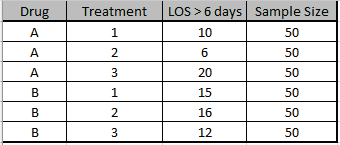

Lognormal: A continuous probability distribution of a random variable whose logarithm is normally distributed.Normal: A commonly occurring continuous probability distribution that is often used in both the natural and social sciences to represent real-valued random variables (in other words, continuous random variables that can take both positive and negative values).Select distributions for comparison: Select one or more distributions to compare.Select a field for analysis: Select a field from the incoming data for analysis.Use the Configuration tab to set the mandatory controls for distribution analysis.
BINOMIAL TABLE TOOL INSTALL
Go to Options > Download Predictive Tools and sign in to the Alteryx Downloads and Licenses portal to install R and the packages used by the R tool. For instance, data that fits a Normal distribution is likely to be well-suited to a Linear Regression, while data that is Gamma Distributed might be better-suited to analysis via the Gamma Regression tool.
BINOMIAL TABLE TOOL HOW TO
The Distribution Analysis tool can be helpful when trying to understand the overall nature of your data as well as make decisions about how to analyze it. Based on the statistical significance (p-values) of the results of these tests, you can determine which distribution best represents the data. Use Distribution Analysis to fit one or more distributions to the input data and compare them based on a number of Goodness-of-Fit* statistics. Go to Sample Workflows to learn how to access this and many other examples directly in Alteryx Designer. This means that out of the 9 people we randomly selected, the probability that 6 or fewer have attended a similar conference in the last year is 0.7287.Distribution Analysis has a One Tool Example. This shows that the probability of 6 or fewer successes is about 0.7287. It will always be in this order: binomcdf(n, p, c). Type in 9, 0.62, 6) and then press enter. How you enter this looks different in each calculator. The probability of success is 0.62 and we are finding P(X ≤ 6). In this problem, there are 9 people selected (n = number of trials = 9). Scroll down to binomcdf near the bottom of the list. This is the type of probability that the binomcdf function is built for! Step 1: Go to the distributions menu on the calculator and select binomcdf. So, we will once again let X represent the number of attendees that have attended a similar conference in the last year. This is the same example we used before, but now we are finding a different probability.

Find the probability that 6 or fewer of these attendees have attended a similar conference in the last year. Suppose that 9 attendees are randomly selected. In other words, this function allows us to calculate the probability of “c or fewer” successes, for some number c.Ī survey determines that 62% of the attendees at a conference have attended a similar conference in the last year. This function will take whatever value we type in, and find the cumulative probability for that value and all the values below it. So, the probability that out of the 9 people we selected, exactly 4 have attended a similar conference in the last year is 0.1475. This shows that the probability of exactly 4 successes is about 0.1475. You will then need to press enter again to get the final answer. It will always be in this order: binompdf(n, p, c).įill in the needed information, highlight paste, and then press enter. Type in 9, 0.62, 4) and then press enter. The probability of success is 0.62 and we are finding P(X = 4). Scroll down to binompdf near the bottom of the list. P(X = 4) Step 1: Go to the distributions menu on the calculator and select binompdf. Let X represent the number of attendees that have attended a similar conference in the last year.

Find the probability that exactly 4 have attended a similar conference in the last year. The binompdf function on your calculator is for finding the probability of exactly some number of successes.Ī survey determines that 62% of the attendees at a conference have attended a similar conference in the last year.


 0 kommentar(er)
0 kommentar(er)
